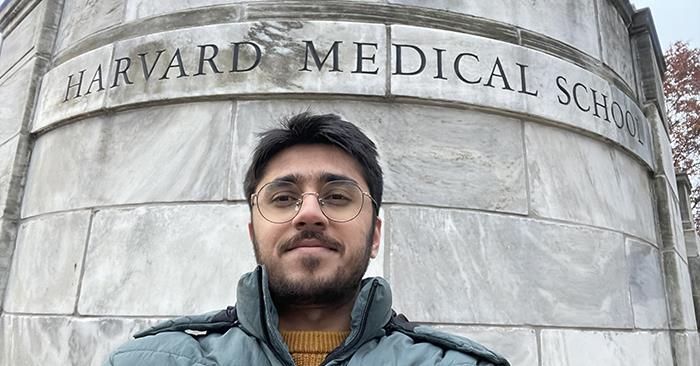Student’s Internships Contribute to Biomedical Research

When it comes curing diseases, computer science is usually not the first major that comes to mind. Recent graduates like Habib Nasir are changing that perspective and demonstrating how an interdisciplinary problem-solving approach can play a critical role in treating devastating diseases. In 2024, Nasir completed two separate internships as a bioinformatics research intern, first at Washington University in St. Louis, and later at Harvard Medical School.
Bioinformatics draws from a multitude of fields including biology, chemistry, physics, computer science, mathematics and statistics to analyze and interpret biological data. The term has been used since the 1970s. With every technological advancement the impact from computer science is amplified in terms of effectiveness.
“Computer science – especially machine learning – allows us to analyze vast datasets to uncover hidden patterns, predict outcomes and build models for personalized medicine,” Nasir said. “My role focuses on analyzing large-scale genetic datasets, building computational pipelines and using statistical and machine learning tools to identify patterns, genes or pathways associated with diseases.”
Playing a role in ending disease was not at the forefront of Nasir’s mind when he came to Truman from Karachi, Pakistan. After working with Colin DeGraff, assistant professor of physics, to use applied data science, Nasir soon saw the real-world impact he could have.
“As I began to explore data science, I realized its potential to revolutionize medicine,” he said. “Combining computational skills with real-world medical challenges has been incredibly fulfilling, especially as I work on building models that could have a direct impact on patients’ lives.”
When an internship at Washington University was advertised to students in the Truman Computer Science Department, Nasir applied and was accepted. He spent the summer focusing on research dedicated to blood cancers such as myelodysplastic syndromes and acute myeloid leukemia.
“It was an incredible experience, and it got me excited to learn more about the field,” he said.
Nasir was so moved by the experience he took it upon himself to find a similar internship for the fall. He began emailing labs and researchers looking for ways he could contribute. After sending hundreds of emails, he got a response from the Khurana Lab at Brigham and Women’s Hospital and the Sunyaev Lab at Harvard. There, he focused on Parkinson’s disease and MSA, a rare condition of the brain and nervous system.
“Working on a brain-related disease like Parkinson’s has been particularly inspiring because machine learning, a form of artificial intelligence, allows us to analyze complex neurological data,” he said. “By studying the mechanisms behind brain diseases, I also gain a deeper understanding of how intelligence works and how the brain functions. This connection between artificial intelligence and biological intelligence fascinates me and motivates me to explore new ways to apply computational tools to unlock insights about the brain.”
Progress sometimes comes with a trade-off, and in Nasir’s field the information he uses to contribute to a future free from disease has somber roots.
“While much of my work involves writing code and analyzing data, I remind myself that every dataset represents real patients,” he said. “This perspective motivates me to approach my work thoughtfully and with a sense of purpose, knowing that even small insights could make a difference in someone’s life.”
In the short term, Nasir hopes his work can help identify genes and pathways linked to diseases and contribute to ongoing research. Eventually, these findings could support the development of targeted treatments, diagnostic tools or biomarker discoveries that improve patient care.
Nasir might be one of the individuals to make long-term contributions based on work he has already done. After graduating from Truman in December with a Bachelor of Science degree in computer science, he accepted a full-time role as a computational biologist at Brigham and Women’s Hospital where he completed his fall internship. He plans to work for at least two years before pursuing a Ph.D.
